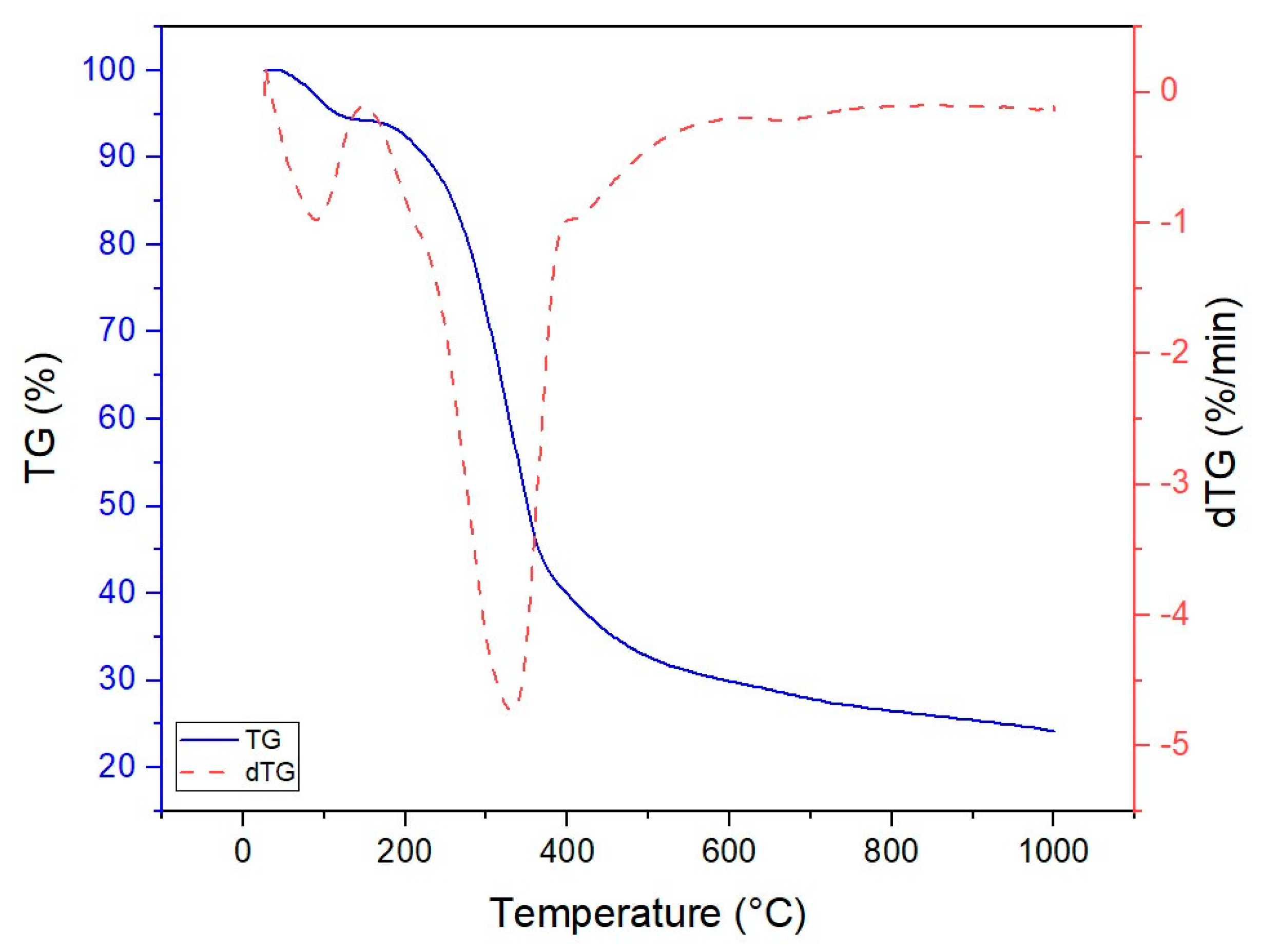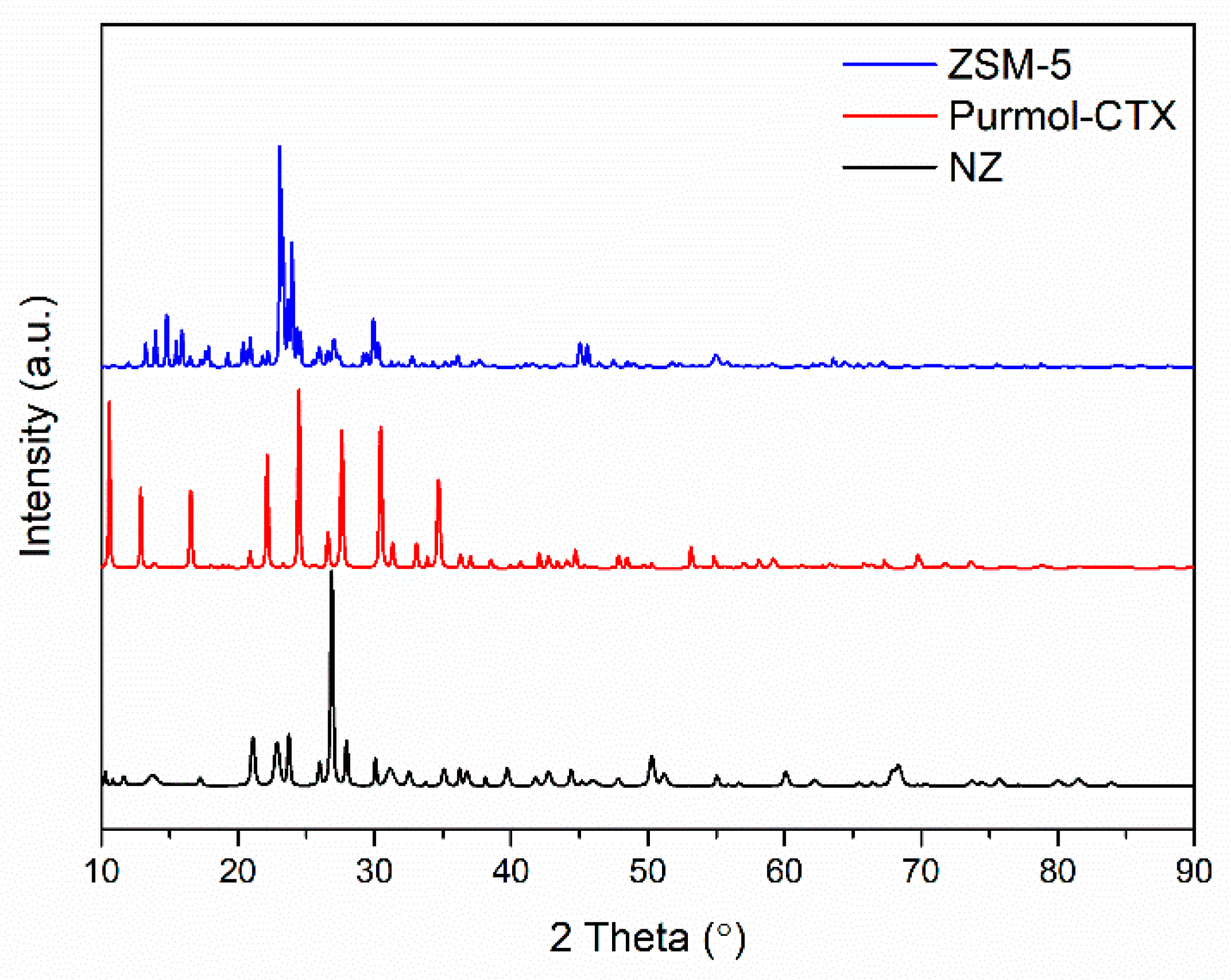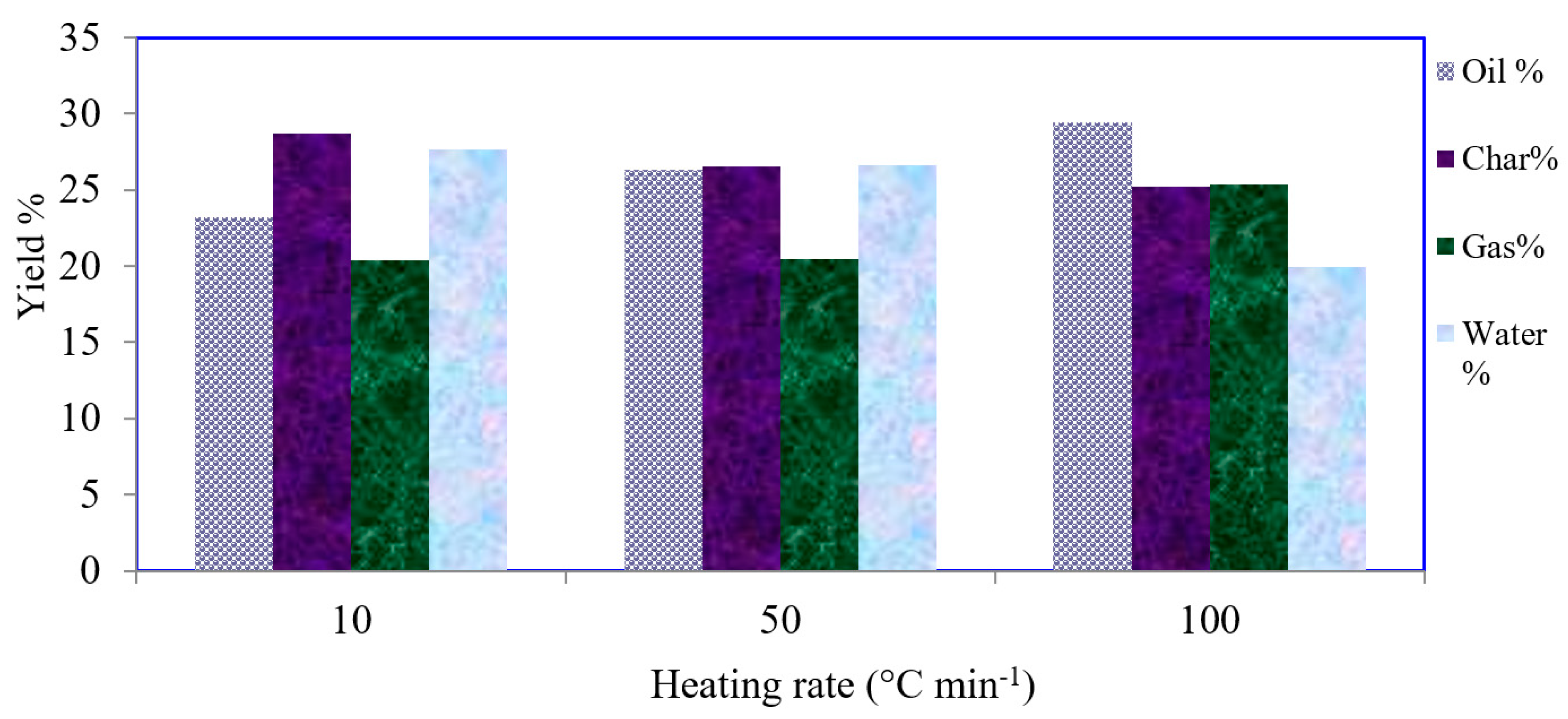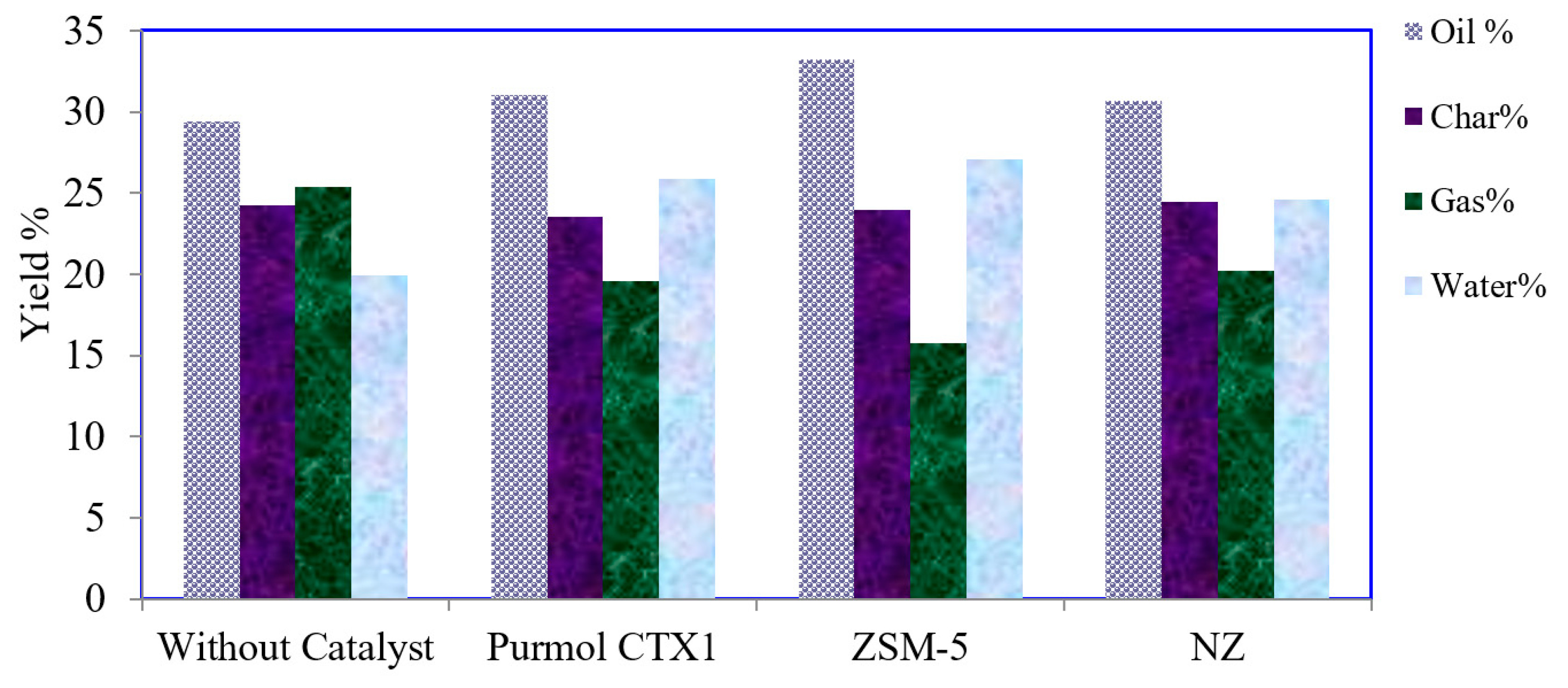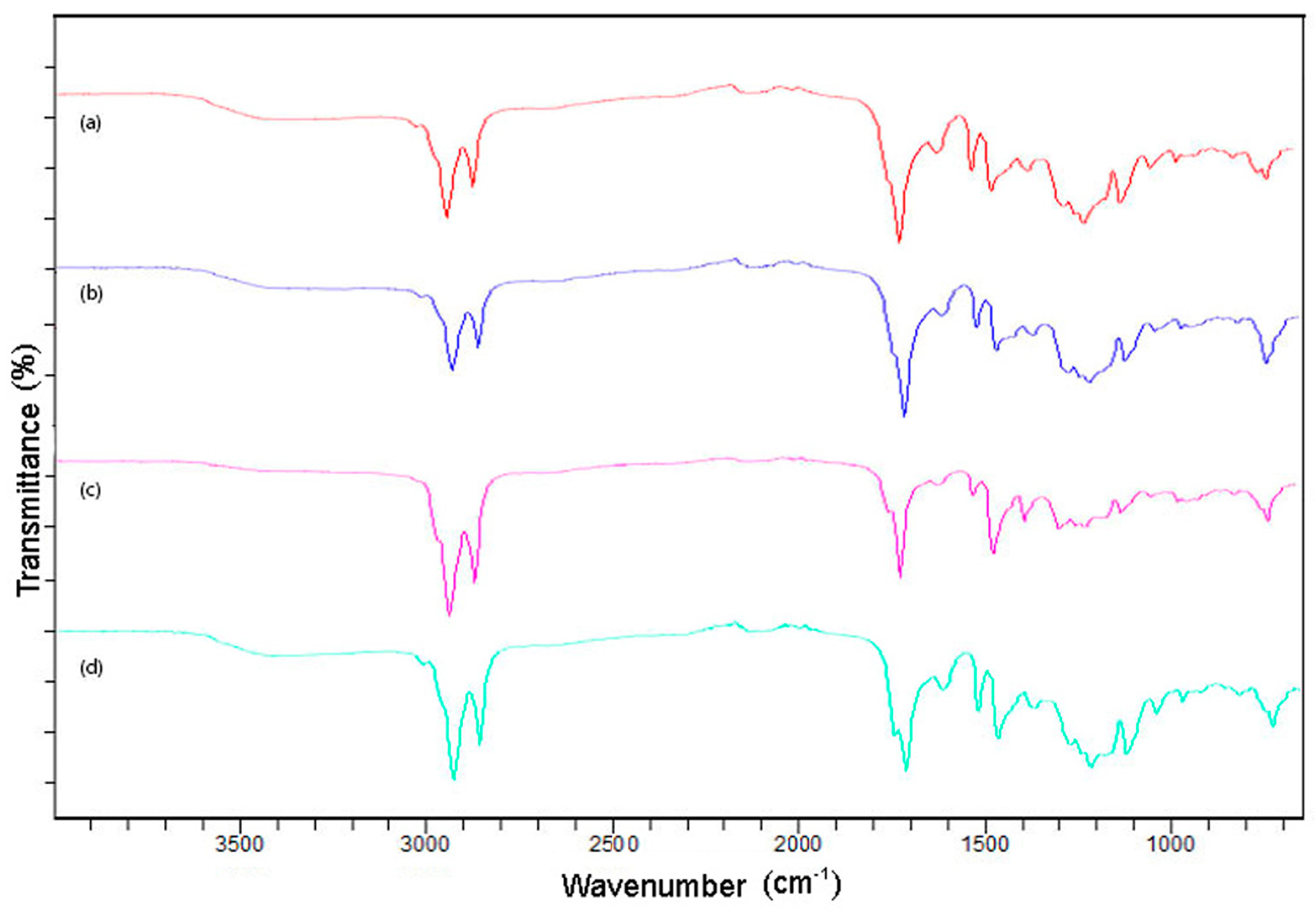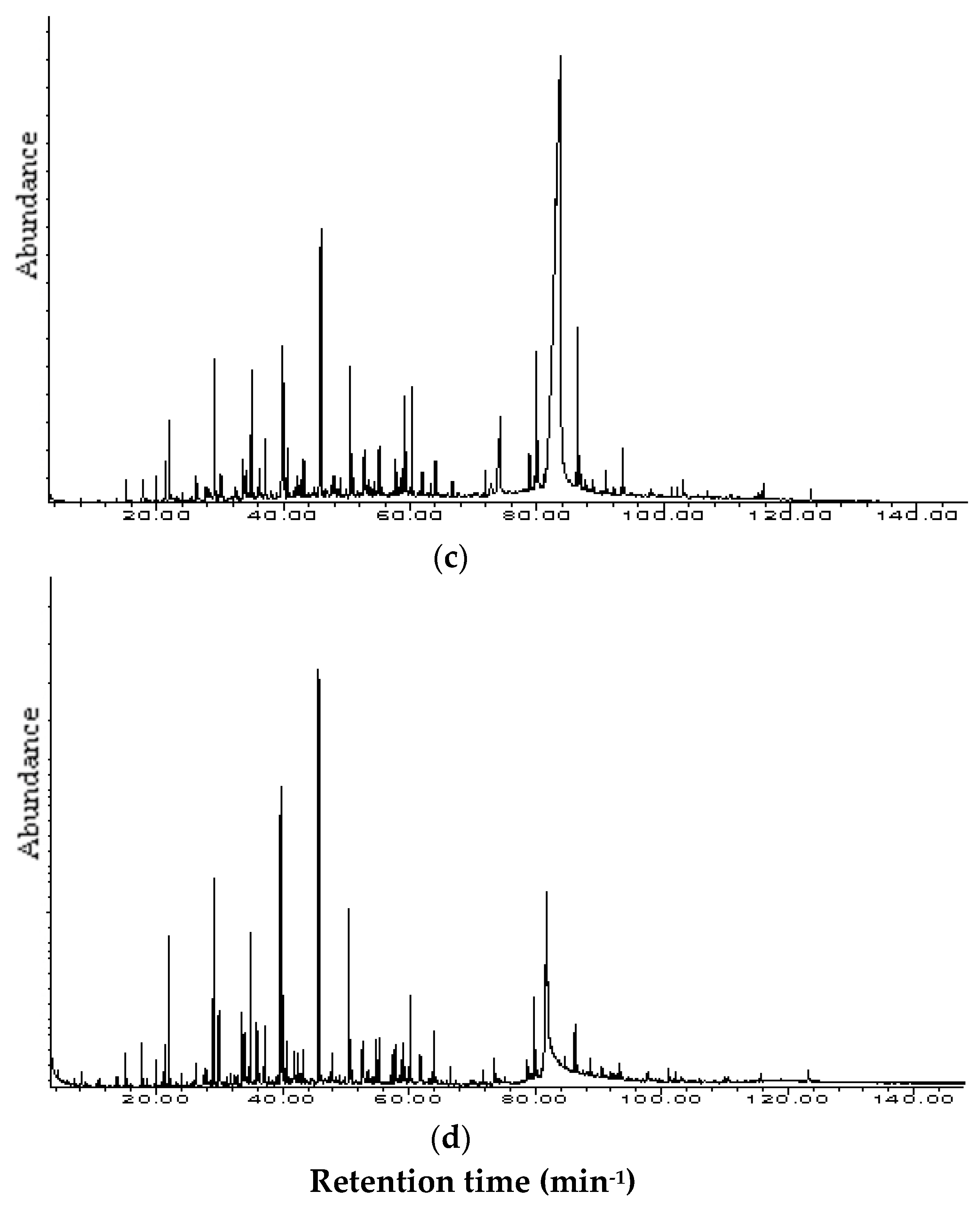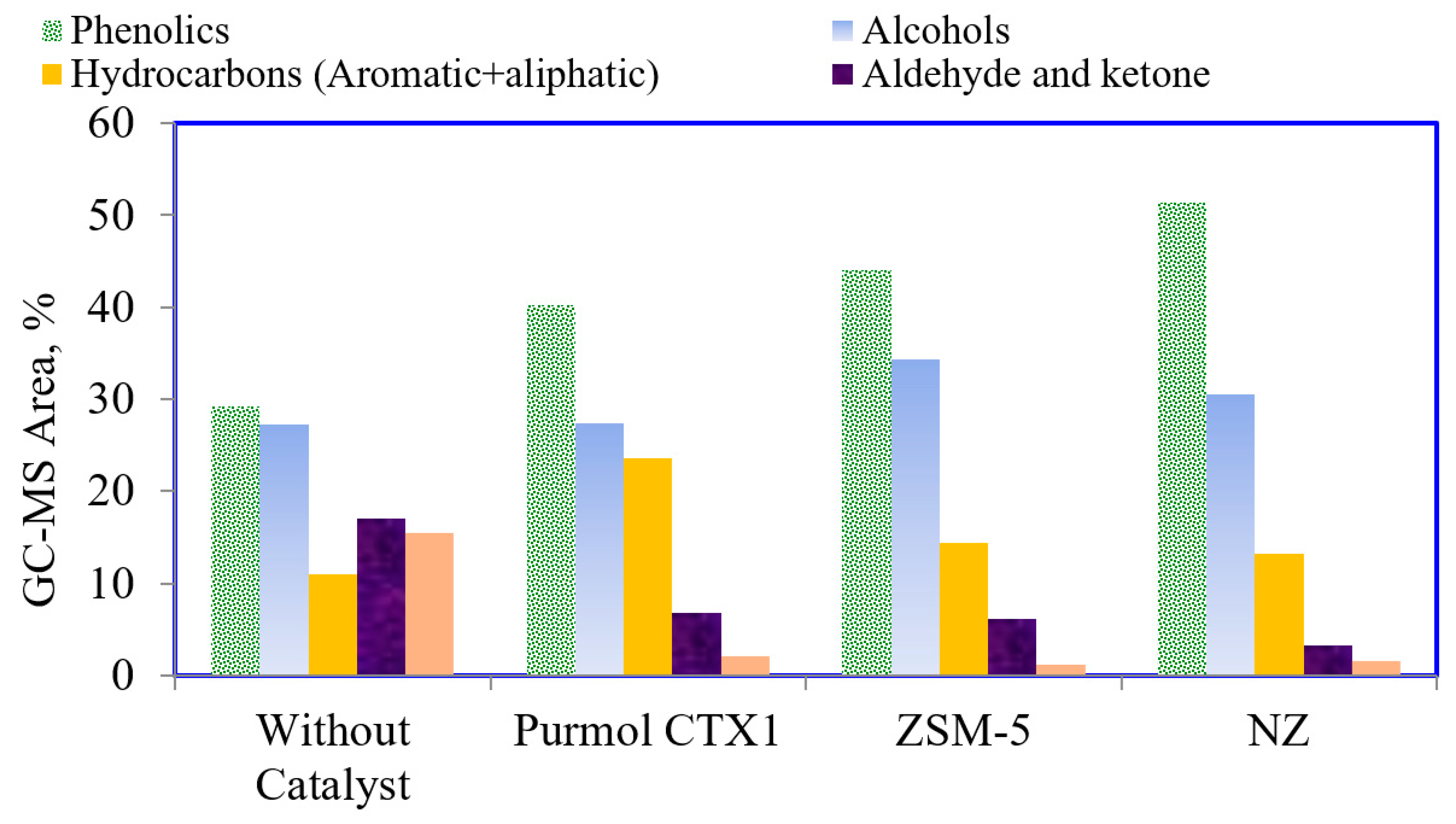3.1. Characterization of the Biomass Sample and Catalysts
Table 1 shows the proximal and final analysis outcomes, which are the atomic H/C and O/C ratios, the calorific value, and the content of the biomass sample. PS contains volatile matter (VM) of 83.84% and a small amount of ash of 0.91, thus making it more advantageous for thermal processes as a high yield of bio-oils and biogas is obtained [
27]. The raw material has a low moisture content (8.87 wt.%), average carbon (43.50 wt.%), and no sulfur content, with a H/C ratio of 1.44. Biomass chemical composition has significant effects on pyrolytic properties. In this way, in this study, the chemical structure of the plum stone was revealed using FT-IR,
1H-NMR, as well as the final and proximal analysis.
Figure 1a shows the plum stone using the FT-IR spectrum. The overlapping bands between 3600 and 3100 cm
−1 T attributed to OH stretching vibrations in the hydroxyl (mainly due to the moisture contents in the raw material), acidic or phenolic groups can be seen in the spectrum. Asymmetric and symmetric C–H bands indicating the presence of alkyl groups for the aliphatic and olefinic structure are seen with two strong bands at 2924 and 2857 cm
−1, respectively. The stretching vibration band between 1770 and 1650 cm
−1 is related to carbonyl groups. The detection of C=C vibrations in aromatic structures between 1650 and 1600 cm
−1 indicates the presence of lignin. The bands between 1060 and 1100 cm
−1 are due to C–O vibrations in olefinic and the aromatic structures, such as saturated ethers, which denote the presence of hemicellulose, cellulose, and lignin [
28]. The
1H-NMR spectra of plum stone are presented in
Figure 1b. It is clearly seen in
Figure 1 that the biomass sample contains 80% aliphatic and 20% aromatic compounds.
Thermogravimetric analyses of plum stone is presented in
Figure 2 and
Table 2. Lignocellulosic biomass is predominantly composed of natural biopolymers such as cellulose, hemicelluloses, and lignin. There is general agreement that the major pyrolytic degradation of the lignocellulosic structure is related to the decomposition of hemicellulose (220–315 °C), cellulose (315–400 °C) and lignin degradation (150–450 °C) [
29]. Pyrolysis reactions can be identified by dTG peaks at a lower temperature of up to 200 °C after the release of moisture at approximately 90–105 °C, with a weight loss of 5.70% in the sample. The maximum loss of weight was determined in the temperature range of 228–400 °C. Hemicellulose begins to degrade at 228 °C and ends at 331 °C, whereas the cellulose decomposition range is between the temperatures of 355–393 °C. Therefore, the losses of weight mentioned here may be attributed to the decomposition of the two. The degradation of lignin occurs between the temperatures of 230–530 °C, but lignin continues to degrade up to higher temperatures [
30]. Since hemicellulose is a heterogeneous polysaccharide composed of different hexoses and pentoses with a lower degree of polymerization, its decomposition temperature is lower than that of cellulose; thus, the intermolecular bond strength is lower than that in cellulose. Since it is a homogeneous polysaccharide consisting only of D-glucopyranose, it has a uniform crystal structure. Hemicellulose and cellulose increase the formation of volatile compounds, and lignin increases the formation of char [
31,
32]. Devolatilization begins at about 200 °C and the removal of volatiles is completed at approximately 528 °C. Maximum heat losses and pyrolytic reactions took place below 550 °C, the most active temperature range. After 540 °C, no weight loss was observed. Therefore, the optimum pyrolysis temperature to maximize bio-oil was 550 °C. PS lost approximately 75.80% of its initial value up to a final temperature of 1000 °C under nitrogen environment.
The analysis of XRD patterns is an effective technique for determining the crystalline structures of zeolites. The structure of the catalysts examined with XRD patterns is given in
Figure 3. In accordance with the literature, featural peaks regarding the orthorhombic, hexagonal, monoclinic, and cubic aluminosilicates structures of zeolites were observed in XRD patterns. A significant diffraction peak was around 2θ = 10–20° and 21–35°, similar to the zeolite crystalline [
33]. The results from the XRF analysis of the catalysts are given in
Table 3. The Si/Al (
w/
w) ratios in clinoptilolite, ZSM-5, and purmol-CTX (as revealed by XRF) were 5.30, 116.57, and 1.06, respectively. The application of zeolites in biomass advancement is related to the acidic properties of the zeolite as well as its structure and textural properties. The low silica-to-alumina ratio was beneficial for cracking, in addition to converting bio-oil oxygenates into aromatics through sequential actions such as dehydration, cracking, decarbonylation, decarboxylation, oligomerization, alkylation, cyclization, and aromatization as well as surface acidity and enhanced thermal stability. Lowering the Si/Al ratio increases the acidity of the catalyst, which, at the same time, changes the surface area and particle size of zeolites [
27]. Clinoptilolite and Purmol-CTX were attributed to a higher proportion of K and Na, respectively. The acidic center and acidic strength have important effects on the catalytic activity of zeolite. Acidity of zeolite catalysts significantly impacts the cracking reactions. Zeolites with different acidic sites elevate the deoxygenation reactions of oxygenates and increase the aromatic yield from the catalytic pyrolysis applications of biomass [
5,
6]. The temperature-programmed desorption of ammonia has been widely applied to obtain the density of total acid sites, and weak- and strong-acid sites in zeolites. Generally, the desorption peaks at temperatures of 200–400 °C represent the medium-acidity sites, and peaks at lower (25–200 °C) and higher temperatures (>400 °C) indicate the weak- and strong-acid sites, respectively [
34]. NH
3-TPD analysis of the samples is demonstrated in
Figure 4. As depicted in this figure, for Purmol CTX, there is a sharp NH
3 desorption peak at about 100 °C and two NH
3 desorption peaks at about 220 and 350 °C, which can be considered weak and the medium acid sites, respectively. In the NH
3-TPD profile of the ZSM-5 and NZ catalysts, two desorption peaks are the low-temperature peaks at around 100 °C and 200 °C, which correspond to weak Lewis-associated acid sites with acid centers.
3.2. Pyrolysis Yields
Pyrolysis temperature is the most important parameter affecting the chemical composition and yield of charcoal, liquid, and gas products. Bhoi et al. [
3] summarized that the majority of biomasses have an active pyrolytic temperature of 400–600 °C, obtained by thermogravimetric analysis, due to their similar compositions in terms of lignin, cellulose, and hemicellulose. In this study, firstly, pyrolysis experiments were conducted at temperature values of 400, 450, 500, and 550 and at a constant heating rate of 100 °C min
−1 with a nitrogen flow rate of 100 cm
3min
−1. The inert gas removes volatiles from the pyrolysis environment during the reaction. Due to the pyrolysis reactions, nitrogen flow affects the residence time of the gas produced, thus minimizing secondary reactions including char formation, recondensation, and repolymerization [
35]. The temperature-dependent relationships of plum stone yields are given in
Figure 5. As shown in the figure, as the pyrolysis temperature increases, gas yields increase; however, the solid yields (char) decrease. For the most part, a temperature increase helped gasify the formed tar; therefore less liquid is obtained at elevated temperatures (550 °C). It can be assumed that at elevated temperatures, secondary reactions of the liquid fraction of volatiles and further decomposition of char particles occur in the reactor [
30]. Accordingly, the highest yield was 29% in the char processed at 400 °C, and the lowest yield was 16.3% in the gas processed at the same temperature. The water content of the bio-oil decreased from 29% to 19%, as the temperature shifted from 400 to 600 °C. At a pyrolysis temperature of 550 °C, the yield of liquid product reached its highest level of 29.43%. Previous studies have indicated that the ideal temperature of pyrolysis to maximize oil yield is between 500 and 600 °C [
8,
20,
36,
37,
38,
39,
40]. Further temperature increases, reaching 600 °C, only increased the gas products. The highest gas yield obtained at a 600 °C pyrolysis temperature was 29.06%. As the temperature increases, the rate of reaction also increases and the long-chained compounds are divided into smaller pieces, resulting in an increase in the yield of gas. Similarly, Naqvi et al. [
13] found that at temperatures higher than 450–600 °C, the yield of gas increased due to secondary oil cracking and biochar decomposition.
In the second part, pyrolysis experiments were performed at heating rates of 10, 50, and 100 °C min
−1; the rate of the sweeping gas flow was constant at 100 cm
3 min
−1 and the pyrolysis temperature was 550 °C. The results obtained are presented in
Figure 6. As the heating rate increased, the yields of liquid increased, while the yields of char decreased. According to the results, while the yield of char was 28.70% at 10 °C min
−1, it decreased to 25.24% at 100 °C min
−1. The pyrolysis reactions and their respective sequences, as well as the composition of the products and the overall yield, are affected by the heating rate. Due to the low energy input per unit time, slow heating rates do not cause cracking of the biomass, contributing to higher coke and biochar formation [
41]. When compared, a higher heating rate reduces the exposure time of the biomass, thus limiting the interference of primary and secondary cracking reactions. Higher heating reduces secondary reactions and promotes the decomposition of previously formed products. Therefore, the bio-oil yield increases at higher heating rates compared to lower heating rates. In studies by Ateş et al. [
26,
42], the pyrolysis of wheat straw was carried out at 500 °C in a fixed-bed reactor. They determined that the bio-oil yield was 19.10% at a heating rate of 7 °C/min, and reached up to 31.90% at a heating rate of 300 °C/min.
In order to obtain the peak yields of oil, catalytic pyrolysis experiments were conducted under ideal conditions in which the heating rate was 100 °C min
−1, the pyrolysis temperature was 550 °C and the sweeping gas flow rate was 100 cm
3 min
−1 in the presence of synthetic zeolites ZSM-5, Purmol CTX and NZ. As can be seen from the results given in
Figure 7, while the highest gas yield obtained with NZ was 20.21%, the highest liquid obtained with ZSM-5, which is an acidic catalyst, was 33.20% and acknowledged for generating nearly 40% of the bio-oil yield [
43]. Akhtar and Saidina-Amin [
44] studied the effect of severity on zeolite-catalyzed biomass pyrolysis on the highest yield from the targeted bio-oil. Lappas et al. [
45] evaluated the application of zeolite acid catalyst in biomass pyrolysis for transportation fuel production. Pütün et al. [
8] carried out the catalytic pyrolysis of cottonseed cake with natural zeolite (clinoptilolite) selected as the catalyst at a pyrolysis temperature of 550 °C with a sweeping gas flow rate of 100 mL min
−1. The highest liquid yield was 30.84% with the catalyst in the amount of 20 wt.% of raw material.
The liquid products obtained as a result of pyrolysis processes contain a high amount of oxygen, which when present in a high proportion in bio-oil leads to an acidic, corrosive, and unstable result with a relatively low energy density. Despite the fact that they are used in numerous applications for heat and power generation, they induce an efficiency decrease when used in motors and turbines. These oils may be improved by catalytic cracking to lower their oxygen content in order to use them directly as a conventional transportation fuel. Soongprasit et al. [
46] studied the rapid pyrolysis of millettia (Pongamia) pinnata waste in a micro-batch pyrolyzer PY- 2020iD with 30% zeolite (USY) catalyst loading under a 5 mL min
−1 sweeping gas (He) flow rate at 400–600 °C at 400–600 °C. Non catalytic bio-oil included 34.1–66.5% of oxygenated compounds. The catalytic pyrolysis increased the hydrocarbon yield to 99%, at which point the oxygenated compounds were converted into aromatic and aliphatic hydrocarbon using decarboxylation and dehydration.
Table 4 shows the elemental compositions of the non-catalytic and catalytic bio-oils. The catalytic bio-oil had a higher carbon content, less oxygen content, and a higher energy content compared to the non-catalytic bio-oil. The pyrolysis oil oxygen content was 32.98% and decreased to 14.04%, 8.45%, and 13.36% by the catalytic treatment with ZSM-5, NZ, and Purmol CTX-1, respectively. As indicated, the effect of zeolite action to remove the oxygen from the pyrolysis oil is obvious. Removing more oxygen causes the calorific value of the fuel to increase.
In terms of environment, a higher H/C ratio of 1.58 for heavy fuel oil, 1.8 for diesel, and 2 for gasoline results in lower greenhouse gas emissions along with improved fuel qualities. Obviously, catalytic enhancement raises the H/C ratio of bio-oil. The H/C ratio of pyrolysis oil, which was found to be 1.52, was increased using catalytic enrichment, and then the ratios were 1.69, 1.75, and 1.77 with NZ, ZSM-5, and Purmol CTX, respectively. A comparison of H/C ratios with conventional fuels showed that the H/C ratios of the oils procured within the scope of this study were between light and heavy petroleum products. The catalysts increased the bio-oil’s calorific value to 24.97–41.75 MJ/kg, corresponding to other conventional fuels such as LPG (45.75 MJ/kg), petroleum (43 MJ/kg), and kerosene (41 MJ/kg) [
25]. When Zhang et al. [
47] used ZSM-5 for the ex situ-mode catalytic pyrolysis of corncobs with a fluidized bed reactor, the resulting bio-oil showed a high calorific value of 34.6 MJ/kg and a 25% reduction in oxygenated compounds, similar to the values of heavy fuel oil and diesel.
Table 5 shows the results obtained from adsorption chromatography. The pyrolysis oil of plum stones contained 76.45% n-pentane insoluble compounds and 23.55% n-pentane solubles. The oil fraction was 15.19% for aliphatic, 27.77% for aromatic, and 57.04% for polar. The fraction of maltenes (n-pentane solubles) was increased to approximately 82% by applying catalytic pyrolysis. The reason for this increase can be explained by the degree of cracking in the course of catalytic pyrolysis. The percentage of maximum aromatics obtained with ZSM-5 was 45.45%, and the percentage of maximum aliphatics obtained with NZ was 24.28%, both of which may be due to the properties of zeolites. The increase in aromatics (e.g., toluene and benzene) and aliphatics (e.g., alkanes and iso-paraffins) is considered favorable for using the products as value-added chemicals and fuels. In addition, the use of catalysts leads to a decrease in polar fractions (usually oxygenated groups). The polar fraction mainly includes carboxylic acids, phenols, aldehydes, furans, and ketones. Thus, the polar fraction of non-catalytic pyrolysis oil decreased from 57.34% to 33.34% subsequent to catalytic application with ZSM-5. Patel et al. [
48] aggregated laboratory experiments and process simulations to gather perception into the technical execution of catalytic and thermal pyrolysis of waste pinewood. Results of the process model calculations showed that catalytic pyrolysis process produces bio-oil of superior quality with properties comparable to conventional fuels.
1H NMR is reported to be a requisite and precise technique for determining hydrogen distributions in bio-oil [
49,
50]. If the hydrogen atoms (main isotope
1H) are abundant in an organic compound, this feature makes it more suitable for a
1H NMR spectroscopy analysis to detect bio-oil constituents. Thus, this technique offers a faster analysis with more precise results [
51].
Table 6 shows a summary of the hydrogen percentages of bio-oils from both catalytic and non-catalytic pyrolysis of plum stone. The
1H NMR spectra were divided into three interest regions related to chemical shifts of specific proton types. The 0.5-3.0 ppm chemical shift region is where aliphatic resonances occur, the 4.5–6.0 ppm region is where the olefinic resonances occur and the 6.0–9.0 ppm region is where the aromatic resonances occur. The high hydrogen content in the aliphatic CH
3–CH
2– and CH– groups was typical for all oils studied. The non-catalytic pyrolysis oil aliphatic content (68%) increased to 72.60% with ZSM-5. These results are consistent with the column chromatography findings. The aromatic hydrogen intensity, mostly occurring between 6.4 and 7.5 ppm, suggests that the aromatic species are mostly phenolic. Together with phenols, IR spectroscopy pointed out that ketones/aldehydes and carboxylic acids are also significant oxygen-containing organics present in polar fractions.
1H-NMR spectra of the bio-oils demonstrate that the natural zeolite bio-oil flavor of catalytic pyrolysis is greater than that of non-catalytic and other catalytic pyrolysis oils. Bio-oil obtained with NZ catalytic pyrolysis gave the highest percentage of aromatic hydrocarbons with 35.23%. Bio-oils obtained by natural zeolite catalytic pyrolysis contain more paraffin and aromatics in comparison to that of non-catalyzed and other catalyst products. Several authors have investigated bio-oil structure with NMR spectroscopy [
49,
50,
51,
52]. Tessarolo et al. utilized
1H NMR for examining bio-oils made from sugarcane bagasse and pine wood. At various temperatures, the bio-oils were produced through non-catalyzed and ZSM-5-catalyzed pyrolysis. The
1H NMR chemical shift integration ranges of all bio-oil samples are shown. In comparison to non-catalytic sugarcane bagasse bio-oil, the bio-oil from ZSM-5 pyrolysed sugarcane bagasse had a higher hydrogen content than aromatic and conjugated alkenes and a lower hydrogen content than oxygen-containing groups. The same ZSM-5 catalyst effect was seen in pine wood bio-oils [
52].
Abnisa et al. used FTIR to determine the chemical structure of the purge natural product brunches, mesocarp fiber buildups, and palm shells [
53]. The FTIR spectra appear as comparable useful bunches in both EFB and mesocarp strands, as is evident in the shapes and the strength of their spectra. The infrared spectrum of palm oil shell demonstrates weaker IR absorbance in comparison to those of mesocarp fiber and EFB, which reflects the affinity of lower volatile substances compared to the mesocarp strands.
Figure 8 shows the FT-IR spectra of the oil. The presence of alcohols and phenols is indicated by O–H stretching vibrations between 3200–3400 cm
−1; the presence of alkenes is indicated by C–H stretching vibrations between 2800–3000 cm
−1 and C–H deformation vibrations between 1350–1475 cm
−1. The presence of aldehydes or ketones is indicated by C=O stretching vibrations between 1650 and 1750 cm
−1. As an indicator of aromatics and alkenes, C=C stretching vibrations are represented by absorbance peaks between 1575 and 1675 cm
−1. It is seen from the spectra that the functional groups of the oils, the functional groups of the oils obtained from cotton seed cake and the chromatographic functions are compatible.
Gas chromatography/mass spectrometry (GC/MS) is considered a fast, advantageous, and effective tool to identify heterogeneous and complex bio-oil samples [
54]. The bio-oil chemical composition was investigated using GC/MS equipment to fully understand how catalysts affect biomass pyrolysis chemistry [
55].
Figure 9 shows the bio-oil gas chromatograms obtained with and without a catalyst. In addition to being used as fuel in boilers and diesel engines, pyrolysis bio-oils are also considered a beneficial source of organic chemicals. The rates of different compounds such as hydrocarbons (aliphatic + aromatic), carbonyls, acid, phenolics, and alcohols found in non-catalytic and catalytic plum stone bio-oils can be seen in
Figure 10. Based on the above-mentioned findings,
Figure 10 should be studied more carefully in terms of the percentage of aliphatics, which appear to be greater with catalysts. It can be concluded that the use of catalysts leads to an advantageous result since aliphatics are critical compounds in terms of their similarity to fuels [
56]. Phenols, which are invaluable industrial products (such as resins, solvents, pharmaceutical raw materials, and pesticides) due to their high commercial value [
41], are the second most crucial compound found in plum stone bio-oil, as can be seen in
Figure 10. Phenols, alkyl phenols, and methoxy phenols are the primary phenolic compounds detected in bio-oils as oligomers and monomeric units extracted from lignin. The total percentage of phenolic compounds increased from 27.17% in non-catalytic bio-oils to 29.28%, 30% and 35% with ZSM-5, purmol, and NZ catalysts, respectively. Pattiya et al. studied cassava rhizome pyrolysis with four catalysts and concluded that the most effective catalyst was ZSM-5, as it caused a remarkable increase in phenols and aromatics [
57]. Using commercial catalysts in-bed and ex-bed modes, Samolada et al. found that phenols were elevated in both modes in comparison to non-catalytic applications [
58]. It is acknowledged that biomass liquids exhibit an acidic structure. However, the presence of acids in pyrolysis oils is undesirable due to their corrosive effects. In this study, carboxylic acids were reduced in bio-oils using catalysts. The total percentages of carboxylic acids observed in the oils were 4.6%, 3.1%, 1.22%, and 0.95% in non-catalytic experiments and using ZSM-5, PURMOL, and NZ catalysts, respectively. A low percentage of acidic compounds observed in the catalytic pyrolysis bio-oils of plum stone can be considered superior in terms of the final quality of the fuel. Since carbonyls undergo condensation reaction, resulting in the formation of higher-molecular-weight components and enhanced viscosity, their presence leads to the issue of instability. However, the amount of carbonyls in the bio-oil is decreased by the catalyst. Subsequent to the deoxygenation and cracking of the oil which occurs in the catalyst pores, the processes of cyclization, isomerization, and aromatization take place. Based on the results of GC/MS, comparing the products obtained from pyrolysis in terms of oxygenated compounds, it was found that the compounds were reduced using a catalyst. In their study, which focused on advancing fast pyrolysis bio-oils with various catalysts in a fixed-bed micro-reactor, Adjaye and Bakshi [
59,
60] observed that H–Y, silica-alumina, and silicate provided more aliphatic hydrocarbons than aromatic hydrocarbons, whereas HZSM-5 and H-mordenite provided more aromatic hydrocarbons than aliphatic hydrocarbons.
Table 7 shows a detailed component analysis of the aliphatic sub-fractions of the pentane-soluble bio-oil using GC/MS, which includes the compound name, peak area, and retention time without the catalyst and with the catalyst. Initially, three groups were formed, C
5–C
11 (gasoline fraction), C
12–C
18 (kerosene-diesel fraction), and C
20–C
38 (heavy oil fraction), respectively, to divide the bio-oil carbon number. For non-catalyst pyrolysis processes, these fractions were distributed as follows: 3.64 wt.% (C
5–C
11), 57.94 wt.% (C
12–C
18), and 38.41 wt.% (C
20–C
38). For catalytic pyrolysis, the carbon number distribution was C
5–C
11, C
12–C
18, and C
20–C
38; in ZSM-5 pyrolysis, bio-oil was 13.08, 66.32 and 20.59 wt.%; in NZ pyrolysis, bio-oil was 12.57, 69.09 and 18.33 wt.%; and in PURMOL-CTX pyrolysis bio-oil was 18.58, 68.80 and 12.60 wt.%, respectively. These results show that after the catalytic application, the long chains of alkanes and alkenes of the pyrolysis oil were converted into lower-weight hydrocarbons. The 3.29% branched obtained without the catalyst increased by, respectively, 8.11%, 10.60%, and 11.97% using ZSM-5 PURMOL CTX and NZ catalysts.


